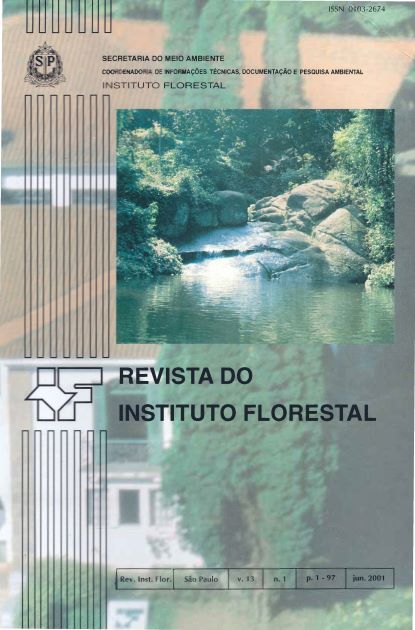SISTEMA DE REPRODUÇÃO EM POPULAÇÕES DE Esenbeckia leiocarpa Engl.
DOI:
https://doi.org/10.24278/2178-5031.2001131626Palavras-chave:
sistema de reprodução, Esenbeckia leiocarpa, eletroforese de isoezimas, genética de populaçõ, fragmentação florestalResumo
O sistema de reprodução de duas populações naturais de Esenbeckia leiocarpa (guarantã) foi estudado em dois fragmentos florestais do Estado de São Paulo, a partir da análise de eletroforese de isoenzimas. A análise da taxa de cruzamento mostrou a espécie como alógama, porém o teste de homogeneidade nas freqüências do conjunto gênico do pólen e d.os óvulos e a correlação. de paternidade ( r ) revelaram que os cruzamentos nas populaçõ'és naturais de E. leiocarpa não foram aleatórios, gerando uma pequena quantidade de indivíduos por cruzamentos entre aparentados e preferenciais. A correlação da taxa de autofecundação ( fs ) revelou que os indivíduos de autofecundação encontram-se aleatoriamente distribuídos dentro das progênies e a correlação de paternidade ( r P ) indicou a existência de uma alta proporção de im1ãos completos dentro das progênies de polinização livre. Por sua vez, comparando os parâmetros do sistema de reprodução entre os fragmentos, verificou-se a ausência de diferenças entre o maior (Caetetus) e o menor (lbicatu) fragmento.
Downloads
Referências
ALFENAS, S. A. Eletroforese de isoenzimas e proteínas afins: fundamentos e aplicações em plantas e microrganismos. Viçosa: UFV, 1998. 574 p.
ALLARD, R. W. Princípios do melhoramento genético das plantas. São Paulo: Edgard Blucher, 1971. 381 p.
CLAYTON, J.; TRETfAK, D. Amine-citrate buffers for pH control in starch gel elcctrophoresis. Journal Fisheries Research Board Canadian, Canada, v. 29, p. 1 169-72, 1972.
CRESTANA, C. S. M.; DIAS. I. S.; KAGEY AMA, P. Y. Biologia floral do guarantã (faenbeckia leiocarpa Engl.). ln: CONGRESSO FLORESTAL BRASILEIRO, 4., 1982, Belo Horizonte. Anais... São Paulo: SBS, 1 982. (Silvicultura, São Paulo, v. 28, p. 35-38, 1982).
ELLSTRAND, N. C. ; ELLAN, D. R. Population genetic consequences of small population sizcs: implication for plant conservation. Annual Review on Ecological Systematics, Davis, v. 24, p. 2 17-242, 1 993.
HAMRICK, J. L. Isozymcs and analysis of genetic structurc in plant populations. ln: SOLTIS, D. E.; SOLTIS, P. (Ed.). Isozymes and the analysis of genetic structure in plant populations. London: Chapman and Hall Ltd., 1 989. p. 87-105.
____ .; GODT, M. J. W. Allozymc diversity 111 plant spec1es. ln: BROWN, A. H. D. et oi. (Ed.). Plant population genetics, breeding and genetic resources. Massachusetts: Sinauer, Sunderland, 1989. p. 43-63.
HAMRICK, J. L.; LOVELESS, M. D. The influence of seed dispersai mechanisms on the genetic structure of plant populations. ln: ESTRADA, A.; FLEMING, T. H. (Ed.). Frugivores and seed dispersai. New York: Junk Publishers, 1 986. cap. 17. 392 p.
____ .; SCHNABEL, A. Understanding the genetic structure of plant populations: some old problems and a new approach. ln: GREGORIOUS, H. R. (Ed.). Lecture notes in biomathematic; population genetics in forestry. Berlin: Springer Verlag, 1 985. p. 50-70.
KEPHART, S. R. Starch gel electrophoresis of plant isozymes: a comparative analysis of techniques. A merican Journal of Botany, Oklahoma, v. 77, n. 5, p. 693-7 12, 1990.
LEWIS, P. O.; ZAYKIN, D. Genetic date analysis. Versão 1. O para Windows 3 .1. 1999. (Não publicado).
RITLAND, K. Series of FORTRAN computer programs for estimating plant mating systems. Journal ofHeredity, Cary, v. 8 1, p. 235-237, 1990. Multilocus mating system program ML TR: version 1.1. Canada: University of Toronto, 1 997. (Não publicado) .
______. ; EL-KASSABY, Y. A. The nature of inbreeding in a seed orchard of Douglas-Fir as shown by an efficient multilocus model. Theoretical Applied Genetics, Berlin, v. 71, p. 375-384, 1985 .
______ ; JAIN, S. A model for the estimation of outcrossing rate and gene frequencies using independent loci. Heredity, Lund, v. 47, p. 35-52, 1981.
SHAW, D. V.; ALLARD, R. W. Estimation of outcrossing rates in Douglas-Fir using isozyme markers. Theoretical Applied Genetics, Berlin, V. 62, p. 1 13-120, 1982.
SQUILLACE, A. E. Average genetic correlations among offspring from open-pollinated forest trees. Silvae Genetica, Frankfurt, v. 23, p. 149-156, 1974.
SURLES, S. E. et ai. Genetic relatedness in open pollinated families of two leguminous tree species, Robinia pseudoacacia L. and Gleditsia triacanthos L. Theoretical Applied Genetics, Berlin, v. 80, p. 49-56, 1990.
SWOFFORD, D. L.; SELANDER, R. B. BIOSYS-1. A FORTRAN computer program for the analysis of allelic variation in population genetics and biochemical systematics. Journal of Heredity, Cary, v. 72, p. 282-283, 1989.
WORKMAN, P.; NISWANDER, J.L. Population studies on southwestem Indian tribes. II. Local genetic differentiation in the Papago. American Journal Human Genetic, Chicago, v. 22, p. 24-49, 1970.
WRIGHT, S. Isolation by distance. Genetics, Washington, v. 28, p. 1 14-138, 1943. The interpretation of population structure by F-statistics with special regard to systems of mating. Evolution, San Francisco, V. 19, p. 395-420, 1 965 .
YOUNG, A. ; BOYLE, T.; BROWN, A. H. D. The population genetic consequences of habitat fragmentation for plants. Tree, Victoria, v.11, n.10, p. 413-418, 1996.















